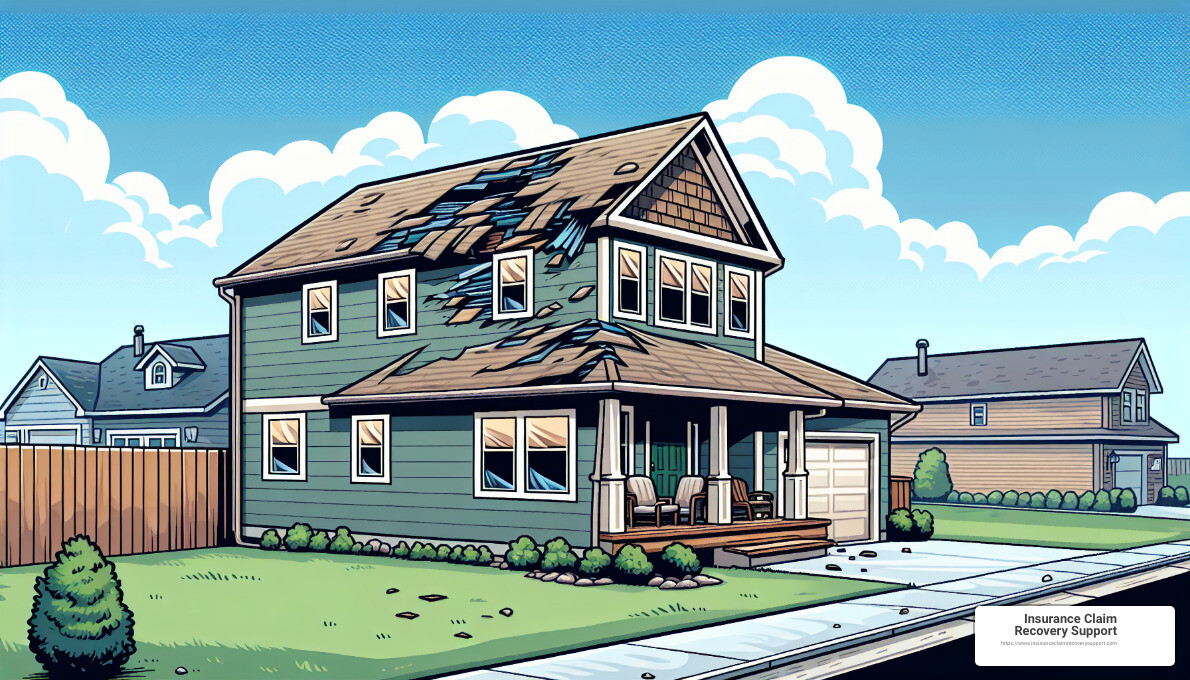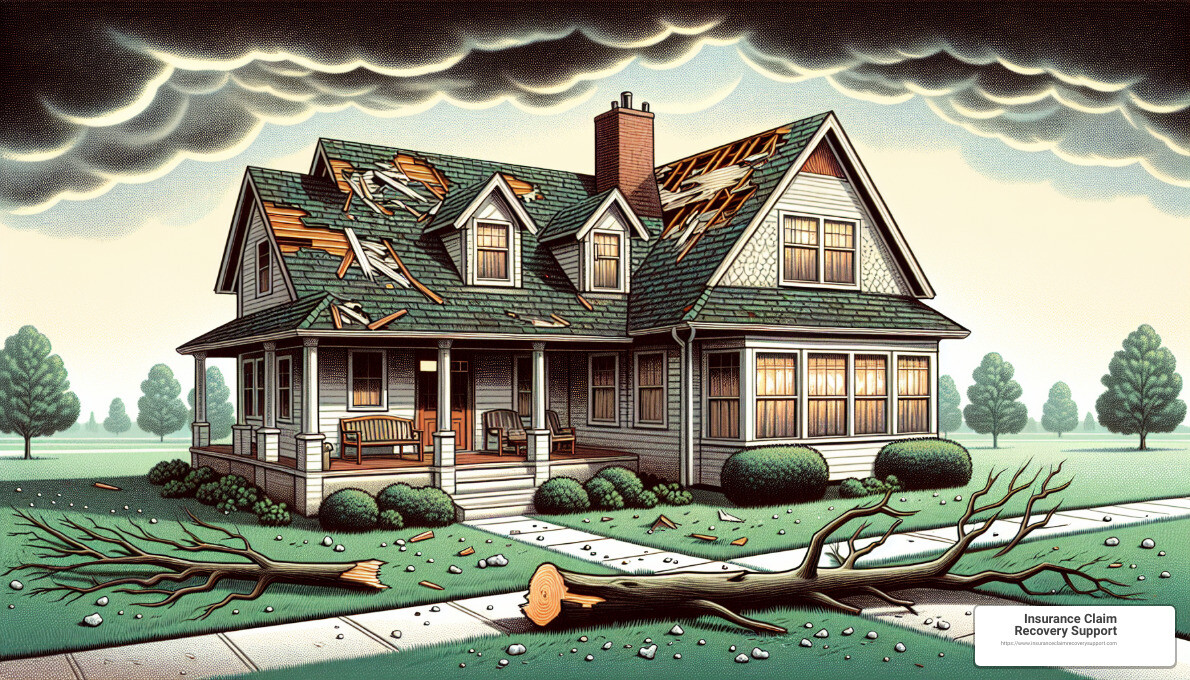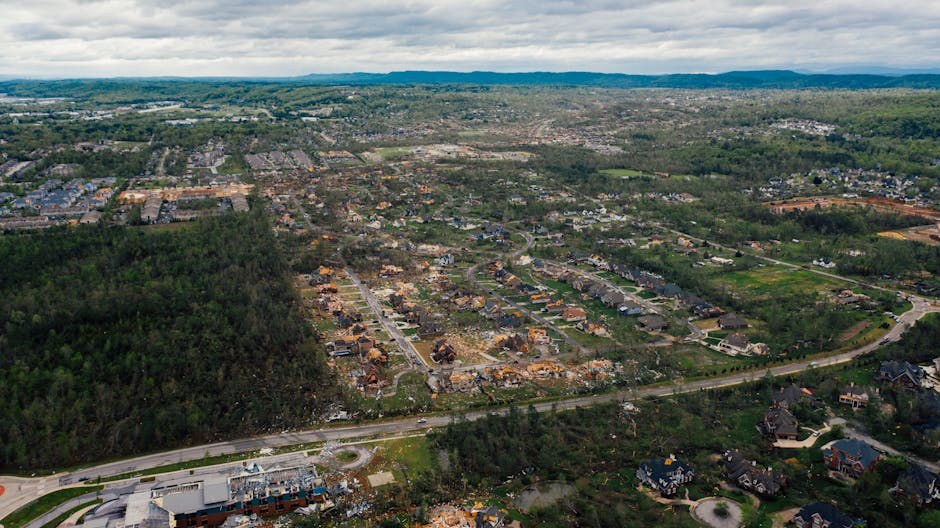Introduction
If you’re trying to wrap your head around what cosmetic exclusion means in your insurance policy, here’s the straight scoop: Cosmetic exclusions in insurance policies refer to damage that affects the appearance of your property but not its functionality. This means if a storm leaves your property looking less than perfect but still structurally sound, your insurance might not cover the repairs. This is especially relevant to property owners in Texas, where harsh weather like hail storms can do a number on your property’s appearance.
- What is Cosmetic Exclusion? Damage to property that involves appearance but not functionality.
- Why it Matters: Your insurance may not pay for repairs if the damage is deemed cosmetic.
- Common in: Texas, where storms cause significant exterior damage to properties.
Given the potential impact on your pocket and your property’s integrity, understanding the ins and outs of cosmetic exclusions is crucial for anyone owning commercial buildings, multifamily complexes, and other properties in storm-prone areas like Texas. With storms becoming more frequent and intense, being informed about what your insurance policy covers (and what it doesn’t) can make all the difference when disaster strikes. In this guide, we delve into what cosmetic exclusions mean for Texas property owners dealing with storm damage and how to navigate these murky waters.

Understanding Cosmetic Exclusions
When your home faces the wrath of a Texas storm, understanding the ins and outs of cosmetic exclusions can be a game-changer. Let’s break it down into simpler terms, focusing on the definition, the clash between functionality and appearance, and how roof damage from hail plays into this scenario.
Definition
At its core, a cosmetic exclusion is a policy clause that says, “If the damage only affects how your property looks but everything still works fine, we won’t cover it.” Imagine your car gets a scratch. It looks bad, but it drives just as well. That’s the essence of cosmetic damage in the insurance world.
Functionality vs. Appearance
This distinction is crucial. Your home could get hit by hail, leaving dents or scratches on the siding or roof. If these blemishes don’t lead to leaks or structural issues, the damage is considered cosmetic. It’s all about appearance vs. functionality. The siding still protects your home, and the roof still keeps the rain out. But, and here’s the kicker, it just doesn’t look as pretty.
Roof Damage
Roofs are particularly vulnerable to hail. After a storm, you might find your roof littered with dents. Here’s where things get tricky. According to a lawsuit involving State Farm in 2021, cosmetic loss was defined as damage that “alters the physical appearance but does not result in water penetration.” This definition can lead to denied claims for homeowners who are left with a roof that looks battered but is technically still functional.
Hail Impact
Hail can be a homeowner’s nightmare, leaving a trail of cosmetic damage in its wake. While superficial, this damage can significantly affect your home’s curb appeal and, potentially, its market value. Yet, under the umbrella of cosmetic exclusions, this type of damage often doesn’t qualify for coverage.
The Bottom Line
Understanding cosmetic exclusions is about recognizing the fine line between what looks bad and what actually impairs function. It’s a tough pill to swallow, especially when your home no longer has that pristine appearance. We’ll explore how these exclusions impact insurance claims and what steps you can take to protect your property and financial well-being.
Navigating cosmetic exclusions requires a keen eye and a clear understanding of your insurance policy. Stay tuned as we delve deeper into how these exclusions play out in real-life scenarios and what you can do to ensure your home remains protected, both functionally and aesthetically.
Types of Cosmetic Damage
When we talk about cosmetic damage, we’re focusing on the kind of harm that doesn’t stop your home from being a safe place to live but does make it look less appealing. This can include a range of issues, from small dents to discoloration, and it often affects several parts of your home. Let’s break down the main areas where cosmetic damage is commonly seen:
-
Metal Roofs: These are durable and long-lasting, but they’re not immune to the wrath of nature. Hail, for instance, can leave behind dents and scratches that don’t necessarily lead to leaks but do impact the roof’s appearance.
-
Siding: Just like your roof, the siding of your home can take a beating during a storm. Hail and high winds can scratch, dent, or even strip paint from your siding, making it look worn and aged.
-
Windows: While most cosmetic damage discussions focus on roofs and siding, windows can also suffer. The frames, in particular, can get scratched or dented. Even if the glass remains intact, the overall look of your windows can diminish.
-
Exterior Components: This broad category includes everything from doors to gutters. Each of these elements can experience cosmetic damage. For instance, gutters can get dinged or bent, affecting the overall curb appeal of your home.
-
Superficial Damage: This term covers all the minor, yet visually impactful, damages that don’t interfere with the functionality of your home’s components. It’s the kind of damage that makes you sigh because your home no longer looks “new,” but it doesn’t necessarily make it unsafe or expose it to the elements.
Cosmetic damage is tricky because it straddles the line between what’s essential for your home’s integrity and what’s necessary for its aesthetic value. Insurance companies often argue that since this type of damage doesn’t affect the home’s ability to provide shelter, it’s not covered under standard policies. This can leave homeowners in a tough spot, facing the choice between living with the damage or paying out-of-pocket for repairs.
As we’ve seen, cosmetic damage can affect almost every exterior part of your home. Understanding what counts as cosmetic damage is the first step in navigating your insurance policy more effectively. Just because the damage doesn’t affect your home’s function, doesn’t mean it won’t affect its value or your enjoyment of it.
Next, we’ll dive into how these exclusions impact insurance claims and what you can do to ensure you’re adequately protected. Stay tuned for actionable tips and insights that can help you navigate the often complex world of home insurance.
The Impact of Cosmetic Exclusions on Insurance Claims
When it comes to cosmetic exclusions in insurance policies, the effects can be wide-ranging and significant. Let’s break down how these exclusions can impact your claims, focusing on claim denials, reduced payouts, out-of-pocket repairs, and property value.
Claim Denials
Imagine you file a claim because a hail storm left your office building’s metal roof looking like a golf ball. You might expect your insurance to cover the repairs. However, with a cosmetic exclusion in place, the insurance company might say, “Yes, it looks bad, but it’s still keeping the rain out.” So, they deny your claim. This is becoming more common, especially in places like Texas, which sees a lot of hail.
Reduced Payouts
Sometimes, instead of outright denying a claim, an insurer might acknowledge the damage but argue that it’s only cosmetic. This can lead to reduced payouts. For example, if the siding of your building is pitted from hail but still intact, the insurer might offer a small amount, far less than the cost of making it look new again.
Out-of-Pocket Repairs
With denials and reduced payouts comes the reality of out-of-pocket repairs. If you want to maintain your property’s appearance and value, you might find yourself paying for repairs yourself. This can be particularly painful for businesses where appearance is crucial, like retail stores or rental properties.
Property Value
Cosmetic damage isn’t just about looks. Property value can take a hit, too. If you decide to sell your property and it has unrepaired cosmetic damage, potential buyers are likely to offer less or demand repairs before purchase. This is something David Moore from Jansen/Adjusters International pointed out, noting that un-repaired hail damage could decrease the resale value of a commercial property significantly.
Navigating Cosmetic Exclusions
Given these impacts, it’s crucial to understand how cosmetic exclusions can affect your insurance claims. The key is to be proactive:
- Review your policy carefully to see if cosmetic exclusions are included.
- Talk to your insurance agent about removing these exclusions or adjusting your coverage.
- Consider the long-term value of your property, not just immediate costs.
Cosmetic exclusions can be a headache, but with the right approach, you can protect your property and your finances. Next, we’ll explore how to protect your property and insurance claims from the effects of these exclusions.
Navigating Cosmetic Exclusions in Texas
Navigating the landscape of cosmetic exclusions in Texas requires a blend of awareness, preparation, and strategic action. Given the state’s susceptibility to severe weather events, understanding the nuances of your home insurance policy is more than just a precaution—it’s a necessity.
Texas Home Insurance and Cosmetic Exclusions
In Texas, the frequency and severity of hail and wind events have led many insurance companies to revise their policies to include cosmetic exclusions. This means that damage to your property, which is deemed cosmetic (i.e., does not affect the functionality of the structure), may not be covered. Cities like Austin, Dallas, Fort Worth, San Antonio, Houston, Lubbock, San Angelo, Waco, Round Rock, Georgetown, and Lakeway are no strangers to such weather phenomena, making it imperative for property owners in these areas to be vigilant.
Policyholder Awareness
The first step in navigating cosmetic exclusions is understanding that they exist. Many policyholders are unaware of these exclusions until it’s too late. It’s crucial to:
- Read your policy documents carefully. Don’t overlook the fine print where such exclusions are often detailed.
- Ask questions. If there’s anything you don’t understand, reach out to your insurance agent for clarification.
Insurance Claim Recovery Support LLC
For those who find the insurance claims process daunting or have had a claim denied or reduced due to cosmetic exclusions, seeking professional help can be a game-changer. Insurance Claim Recovery Support LLC specializes in advocating for policyholders, ensuring that your claim is fairly assessed and that you receive the compensation you’re entitled to. Their expertise can be particularly beneficial in navigating the complex landscape of Texas home insurance.
Protecting Your Property and Claims
Being proactive can significantly mitigate the impact of cosmetic exclusions on your insurance claims. Consider the following steps:
- Policy Review: Before renewing or purchasing a new policy, review it for any cosmetic exclusions. Understanding what your policy covers and what it doesn’t is crucial.
- Exclusion Removal: If your policy includes cosmetic exclusions, discuss with your agent the possibility of removing them. Be prepared that this may affect your premium.
- Premium Adjustments and Deductible Considerations: Weigh the cost of potential out-of-pocket repairs against the increased premium or deductible costs for exclusion removal. Sometimes, paying a bit more on your premium can save you significantly in the long run.
- Seek Professional Help: Companies like Insurance Claim Recovery Support LLC can provide valuable guidance and support, whether you’re reviewing a new policy, dealing with a current claim, or seeking to challenge a denied claim due to cosmetic exclusions.
Conclusion
In Texas, where the weather can be as unpredictable as the outcome of an insurance claim, being informed and prepared is your best defense against the challenges posed by cosmetic exclusions. Whether you’re in bustling Austin or the windswept plains of Lubbock, understanding your home insurance policy’s fine print can make all the difference when disaster strikes. You don’t have to navigate this alone—professional help is available to ensure your property and finances are protected.
Next, we’ll delve into how to protect your property and insurance claims from the effects of these exclusions, ensuring you’re fully prepared for whatever the Texas weather throws your way.
How to Protect Your Property and Insurance Claims
When it comes to safeguarding your property and ensuring your insurance claims are honored, knowledge and preparation are your best defenses. Let’s break down the steps you can take to protect your interests:
Policy Review
Start with a thorough review of your insurance policy. This might sound daunting, but it’s essential. Look for the sections on exclusions and limitations, and pay special attention to anything mentioning “cosmetic damage.” Understanding what your policy covers and what it doesn’t is the first step to ensuring you’re not caught off guard.
Exclusion Removal
Consider negotiating the removal of cosmetic exclusions. While not always possible, some insurers may be willing to remove these exclusions for an additional fee. This could be a worthwhile investment, especially in areas prone to hail and wind damage, like Texas. It’s a conversation worth having with your insurance agent.
Premium Adjustments
Be prepared for premium adjustments. If you’re successful in removing cosmetic exclusions or enhancing your coverage in other ways, know that your premiums may increase. Weigh the cost against the potential out-of-pocket expenses for repairs that wouldn’t be covered otherwise. In many cases, paying a bit more each month could save you thousands in the long run.
Deductible Considerations
Evaluate your deductible. A higher deductible can lower your premium costs, but it also means higher out-of-pocket expenses when you file a claim. Choose a deductible that balances affordability with your ability to pay it in the event of a claim.
Professional Help
Seek professional help. Navigating insurance policies and negotiating with insurers can be complex. Professionals like public adjusters or insurance claim specialists have the expertise to review your policy, suggest changes, and even advocate on your behalf if a claim is denied or underpaid. Their knowledge can be invaluable, especially when dealing with something as nuanced as cosmetic exclusions.
Protecting your property and insurance claims from the impact of cosmetic exclusions doesn’t have to be a solo endeavor. With careful policy review, strategic negotiations, and the right professional assistance, you can secure the coverage you need to safeguard your property against the unpredictable Texas weather.
Keep these strategies in mind to ensure you’re not just covered, but truly protected. Next, we’ll address some of the most frequently asked questions about cosmetic exclusions to help clarify any remaining uncertainties.
Frequently Asked Questions about Cosmetic Exclusions
Navigating insurance, especially when it comes to understanding what your policy covers, can be tricky. Cosmetic exclusions often add another layer of complexity. Let’s break down some of the most common questions you might have.
What counts as cosmetic damage?
Cosmetic damage refers to any damage that affects the look of your property but doesn’t interfere with its function. Imagine a hailstorm leaves dents on your metal roof. It looks less appealing, but rain doesn’t leak through. That’s cosmetic. This can include:
- Dents in siding or roofing
- Scratched windows
- Minor damages to exterior paint
It’s about appearance, not function.
How do cosmetic exclusions affect my insurance claim?
When your policy includes a cosmetic exclusion, it means the insurance won’t pay for repairs that are purely for looks. If a storm damages your roof but it still keeps water out, you might have to pay out-of-pocket to fix those dents or scratches. This can lead to:
- Claim denials for damage deemed cosmetic
- Reduced payouts, since functional damage is covered but cosmetic isn’t
- Out-of-pocket repairs to maintain your property’s value and appearance
Can I remove cosmetic exclusions from my policy?
Yes and no. It depends on your insurance provider and the options they offer. Here’s how you can approach it:
- Talk to your insurance agent. Ask about your current coverage and if there are options to adjust it.
- Shop around. Some insurers might offer policies without cosmetic exclusions, or with more favorable terms.
- Consider premium adjustments. Removing exclusions might increase your premium, but it could be worth it for more comprehensive coverage.
- Professional help. Consulting with experts like those at Insurance Claim Recovery Support can provide insights into the best course of action for your specific situation.
Understanding the ins and outs of your policy is crucial. If you’re unsure about your coverage, reaching out for professional advice can help clear up confusion and ensure you’re adequately protected.
As we wrap up this section, keep in mind that being proactive about your insurance coverage can save you time, money, and stress in the long run. Don’t wait for the next storm to find out what your policy covers. Take steps today to ensure your property is protected, both functionally and cosmetically.
Conclusion
Navigating the complex world of insurance claims, especially when dealing with cosmetic exclusions, can seem daunting. However, you’re not alone in this journey. At Insurance Claim Recovery Support LLC, we’re committed to standing by your side, providing expert guidance and support every step of the way.
Cosmetic damage, though it might seem minor, can have significant implications for the value and integrity of your property. Understanding the nuances of your insurance policy’s cosmetic exclusions is crucial to ensuring you receive the coverage you’re entitled to. But we understand that diving into the fine print of insurance policies and negotiating with insurers isn’t everyone’s forte. That’s where we come in.
Our team specializes in helping Texas property owners navigate the complexities of storm damage claims. From Austin to Dallas, and Houston to San Angelo, we’ve seen how hail and storm damage can impact communities. We know that what might be classified as “cosmetic” by insurers can still carry substantial repair costs and affect the functionality of your property.
At Insurance Claim Recovery Support LLC, we leverage our expertise to advocate for your rights as a policyholder. Whether it’s conducting a thorough assessment of the damage, challenging unjust claim denials, or negotiating with insurance companies on your behalf, our goal is to ensure you receive the maximum compensation possible.
The aftermath of a storm shouldn’t leave you feeling lost or overwhelmed. With the right support and guidance, you can navigate cosmetic exclusions and secure the funds needed to repair and protect your property. Let us help you turn a potentially stressful insurance claim process into a success story.
For more information on how we can assist with your specific situation, or to learn more about protecting your property against Texas storm damage, visit our loss types service page. Let’s work together to ensure your property is fully protected, today and in the future.









